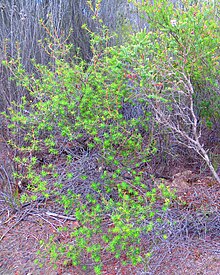| Flame heath | |
|---|---|

| |
| In Monarto South, Australia | |
| Scientific classification | |
| Kingdom: | Plantae |
| Clade: | Tracheophytes |
| Clade: | Angiosperms |
| Clade: | Eudicots |
| Clade: | Asterids |
| Order: | Ericales |
| Family: | Ericaceae |
| Genus: | Stenanthera |
| Species: | S. conostephioides |
| Binomial name | |
| Stenanthera conostephioides Sond. | |
| Synonyms | |
| |

Stenanthera conostephioides, commonly known as flame heath, is a species of small shrub that is endemic to south-eastern continental Australia. It has linear to lance-shaped leaves, red, tubular flowers and green, oval fruit turning dark red.
Description
Stenanthera conostephioides is an erect or spreading shrub that typically grows to a height of 20–100 cm (7.9–39.4 in). The leaves are thick, linear to lance-shaped, 7–21 mm (0.28–0.83 in) long and 0.8–2 mm (0.031–0.079 in) wide, with a pointed tip 1.1–1.5 mm (0.043–0.059 in) long. The flowers are red and occur singly, pendent and tube-like, more or less cylindrical and 6.3–15 mm (0.25–0.59 in) long. There are brownish bracts 0.5–10 mm (0.020–0.394 in) long and bracteoles 6.3–15 mm (0.25–0.59 in) long at the base of the flower, and the sepals are brownish 7.7–18 mm (0.30–0.71 in). The petal lobes are densely hairy on the inside near their tips. The anthers project beyond the end of the petal tube and the style is 10–19 mm (0.39–0.75 in) long. The fruit is oval, about 9–11 mm (0.35–0.43 in) long and green tinged with maroon, later dark red. Flowering occurs from March to November.
Taxonomy and naming
Stenanthera conostephioides was first formally described in 1845 by Otto Wilhelm Sonder in Lehmann's Plantae Preissianae from specimens collected by Theodor Siemssen near Port Adelaide in 1839. The specific epithet (conostephioides) refers to the similarity of this species to a plant in the genus Conostephium.
Distribution and habitat
Flame heath grows in mallee scrub and open forest in sandy soil. It is a common species, occurring in western Victoria and the south east of South Australia.
Ecology
The flowers of this species form an important part of the diet of emus.
References
- ^ "Stenanthera conostephioides". Australian Plant Census. Retrieved 5 March 2020.
- ^ "Stenanthera conostephioides". South Australian Seed Conservation Service. Retrieved 5 March 2020.
- ^ Messina, Andre; Stajsic, Val. "Stenanthera conostephioides". Royal Botanic Gardens, Victoria. Retrieved 5 March 2020.
- "Astroloma conostephioides". Electronic Flora of South Australia Fact Sheet. State Herbarium of South Australia. Retrieved 5 March 2020.
- "Stenanthera conostephioides". APNI. Retrieved 5 March 2020.
- Otto W. Sonder (1845). Johann G.C. Lehmann (ed.). Plantae Preissianae. Hamburg: Sumptibus Meissneri. p. 296297. Retrieved 5 March 2020.
- "Siemssen, G. Theodor (fl. 1838)". Council of Heads of Australasian Herbaria Australian National Herbarium. Retrieved 5 March 2020.
- Quin, BR (1996). "Diet and Habitat of Emus Dromaius novaehollandiae in the Grampians Ranges, South-western Victoria". Emu. 96 (2). Birds Australia: 114–122. doi:10.1071/MU9960114.
| Taxon identifiers | |
|---|---|
| Astroloma conostephioides |
|
| Stenanthera conostephioides | |